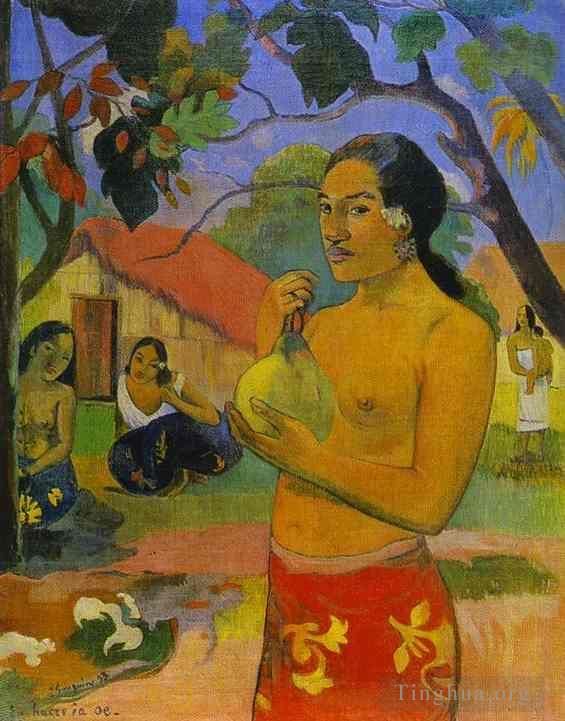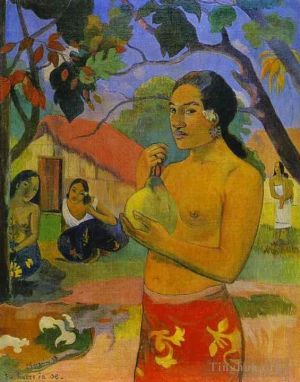Woman Holding a Fruit (Where Are You Going or Eu haere ia oe)
Paul Gauguin
- Price: Price on Request
- Art Type: Oil Painting
- Size:
- English Comments: 0
- International Comments: 0
- Creating Date:
- Introduction and Works of Paul Gauguin >>
Work Overview
- Woman Holding a Fruit; Where Are You Going? (Eu haere ia oe)
Paul Gauguin
Original Title: Ea haere ia oe
Date: 1893; French Polynesia *
Style: Post-Impressionism
Period: 1st Tahiti period
Genre: genre painting
Media: oil, canvas
Dimensions: 73.5 x 92.5 cm
Location: Hermitage Museum, Saint Petersburg, Russia
Tahiti was for Gauguin the embodiment of that primitive and unspoiled life of which he dreamed, of natural harmony and simplicity. He intially spent two years in Tahiti (1891-1893) before returning to Paris for a short time. This work dates from that first period in Oceania, when the artist was still more concerned with the external attributes of the exotic world full of mystery, so unlike Europe. The impressions of the colours and vegetation, the appearance and rituals of the Tahitians, gave the artistic much material to work with. An everyday episode in the islanders' life is here turned into the embodiment of the eternal rhythm of life, of harmony between man and nature. Standing in the foreground is a Tahitian girl with a fruit in her hand - the Eve of that eastern Paradise. Rejecting the rules of traditional painting, and then of Impressionism, Gauguin went on to create his own individual style. The flat space, the rhythmic repetition of lines, forms and areas of colour, and the pure colours applied in broad masses combine to create a highly decorative effect.
The Maori title of the picture is translated as “Where are you going?”. By this question the Tahitians usually greet the person they meet. The fruit, in fact, is a pumpkin in which water was brought. The art researchers consider that the prototype of the depicted woman was Pahura, the tahitian wife of the artist. Her calm and dignified figure is perceived as the figure of an oceanic paradise Eva. The vessel for water, in this case, is symbolic, because water is the symbol of life. The tahitian woman with a baby in her hands in the background is the hint that during the work on the canvas Pahura was pregnant. The Tahitian holding a greenish-lemon colour fruit is painted in beautiful and sophisticated golden-brown shade. The clear line contouring the body adds density and expressiveness to the figure. The scenery, as well as the figure, is interpreted loosely. There is no sunshine or air vibration in the picture, but the burning heat of the tropic sun is felt in everything – in the colour of the woman’s skin, in the blue of the sky, in the still boughs, in the intensive red spots of the clothes and also in the peculiar slow rhythm penetrating the whole picture.
Despite the prominence and importance of titles in Gauguin's art, their meaning is often far from evident, and there seems to be a degree of capriciousness in their choice. It is far from clear who is posing the question here and indeed why, although the woman's insistent gaze seems to suggest direct communication with the spectator. It is possible that it was posed to the artist himself by the archetypal Tahitian woman, since Gauguin was to leave Polynesia later that year. If that is so, then the ripe exotic fruit she nurses to her breast becomes a symbol of the sensual gratification he will leave behind by going back to French 'civilization'. Quotations from other paintings are included, most notably the crouching maiden from Nafea faa ipoipo, who acts as a further reminder of what he will miss.
- Copyright Statement:
All the reproduction of any forms about this work unauthorized by Singing Palette including images, texts and so on will be deemed to be violating the Copyright Laws.
To cite this webpage, please link back here.
- >> English Comments
- >> Chinese Comments
- >> French Comments
- >> German Comments
- >>Report
- Ceramic Vase with a Caricature Self Portrait
- Ceramic vase with Tahitian Gods Hina and Tefatou
- Girl with a Fan
- Te avae no Maria Month of Maria
- Cattle Drinking
- The Call
- Ford Running Away
- Horse on Road Tahitian Landscape
- Three Tahitian Women Against a Yellow Background
- Ta Matete We Shall Not Go to Market Today
- The Seine in Paris between the Pont d Lena and the Pont de Grenelle
- Yellow Hay Ricks Fair Harvest
- Te Vaa The Canoe
- The Seine at the Pont d Iena Snowy Weather
- Day of the God (Mahana No Atua)
- Barbarous Tales
- Fatata te moua At the Foot of a Mountain
- Te Tiare Farani Bouquet of Flowers
- Aube the Sculptor and His Son
- Apple Trees in Blossom
- Baby The Nativity
- Vahine no te vi Woman with a Mango
- Les Alyscamps Arles
- Mandolina and Flowers
- Breton Shepherdess
- Aha oe feii Are You Jealous
- Spirit of the Dead Watching
- The Meal The Bananas
- Mimi and Her Cat
- Tahitian Women On the Beach
- Vahine no te tiare Woman with a Flower
- Joyeusete Arearea
- Siesta
- Bonjour Monsieur Gauguin
- Adam and Eve
- Fatata te miti Near the Sea
- Matamoe Landscape with Peacocks
- The Alyscamps
- The Yellow Christ
- Te Tamari No Atua Nativity
- Madame Alexandre Kohler
- Sunflowers
- Fruits
- Tahitian Landscape
- Piti Teina Two Sisters
- Les Parau Parau Conversation
- Horsemen on the Beach
- Two Breton Women on the Road
- The Fisherwomen of Tahiti
- Merahi metua no Tehamana Ancestors of Tehamana
- La Belle Angele Portrait of Madame Satre
- Te Faaturuma Brooding Woman
- Study of a Nude Suzanne Sewing
- Ia Orana Maria Hail Mary
- Vairumati
- Bouquet of Flowers with a Window Open to the Sea Reverse of Hay Making in Brittany
- Portrait of a Woman with Cezanne Still Life
- Portrait of Gauguin s Daughter Aline
- Mother and Daughter
- Eve Don t Listen to the Liar
- Harvesting of Grapes at Arles Miseres humaines
- Palm Trees on Martinique
- Effect of Snow
- Tahitian Idyll
- Haystacks in Brittany
- Woman Holding a Fruit (Where Are You Going or Eu haere ia oe)
- Taperaa Mahana
- When Will You Marry
- The Four Breton Girls c
- Motherhood Women on the Shore
- Portrait of the Artist with the Idol
- Whats New? (Parau Api or Two Women of Tahiti)
- Hay Making in Brittany
- Still Life with Mangoes
- The Cellist Portrait of Upaupa Scheklud
- Te Pape Nave Nave Delectable Waters
- Man Picking Fruit from a Tree
- 5 Horsemen on the Beach
- At the Pond
- The Schuffenecker Family
- Nevermore O Taiti
- Aita Tamari vahina Judith te Parari Annah the Javanese
- Landscape
- Paysannes bretonnes Breton peasant women
- Still Life with Fan
- Ondine
- Where Do We Come From? What Are We? Where Are We Going?
- Black Pigs
- Rave te hiti aamy The Idol
- Tarari maruru Landscape with Two Goats
- Self portrait
- The Swineherd Brittany
- Bouquet
- Vision of the Sermon (Jacob Wrestling with the Angel)
- Washerwomen at Pont Aven
- Women from Arles in the Public Garden the Mistral
- And the Gold of Their Bodies Et l or de leurs corps
- Scenes from Tahitian Life
- Still Life with Mandolin
- No te aha oe riri Why Are You Angry
- Breton Girls Dancing Pont Aven
- Two Tahitian Women
- Pastorales Tahitiennes
- Parau na te varua ino Words of the devil
- Huts under Trees
- Self Portraits
- Tahitian Woman c
- The Great Buddha
- Breton Landscape The Moulin David
- Night Cafe at Arles
- Portrait of William Molard
- Bouquet of Flowers
- Eiaha Ohipa Not Working
- Three Tahitians
- Self Portrait c
- Van Gogh Painting Sunflowers
- Madeleine Bernard
- Nave Nave Moe Miraculous Source
- Breton Village in Snow
- Portrait de l artiste Self portraitc
- Portrait of Mother
- Caricature Self Portrait
- Nave Nave Moe Sacred Spring
- Vairaumati tei oa Her Name is Vairaumati
- At the Window A la fenetre
- Self Portrait c1894
- Te arii vahine The King s Wife
- Portrait of the Artist with the Yellow Christ
- The White Horse
- Self Portrait 1896
- Be in Love and You Will Be Happy
- Nirvana Portrait of Meyer de Haan
- M Loulou
- Floral and Vegetal Motifs
- Musique barbare
- The Messengers of Oro
- Tahitian Eve c
- Head of a Negress
- Still Life with Three Puppies2
- Words of the Devil c
- Head of a Woman
- Te Arii Vahine Queen
- Study for the Bathers
- Breton Girls Dancing
- Still Life with Three Puppies1
- Tahitian Woman in a Landscape
- Study for La perte de Pucelage The Loss of Virginity
- Pape Moe Mysterious Water









 Singing Palette
Singing Palette